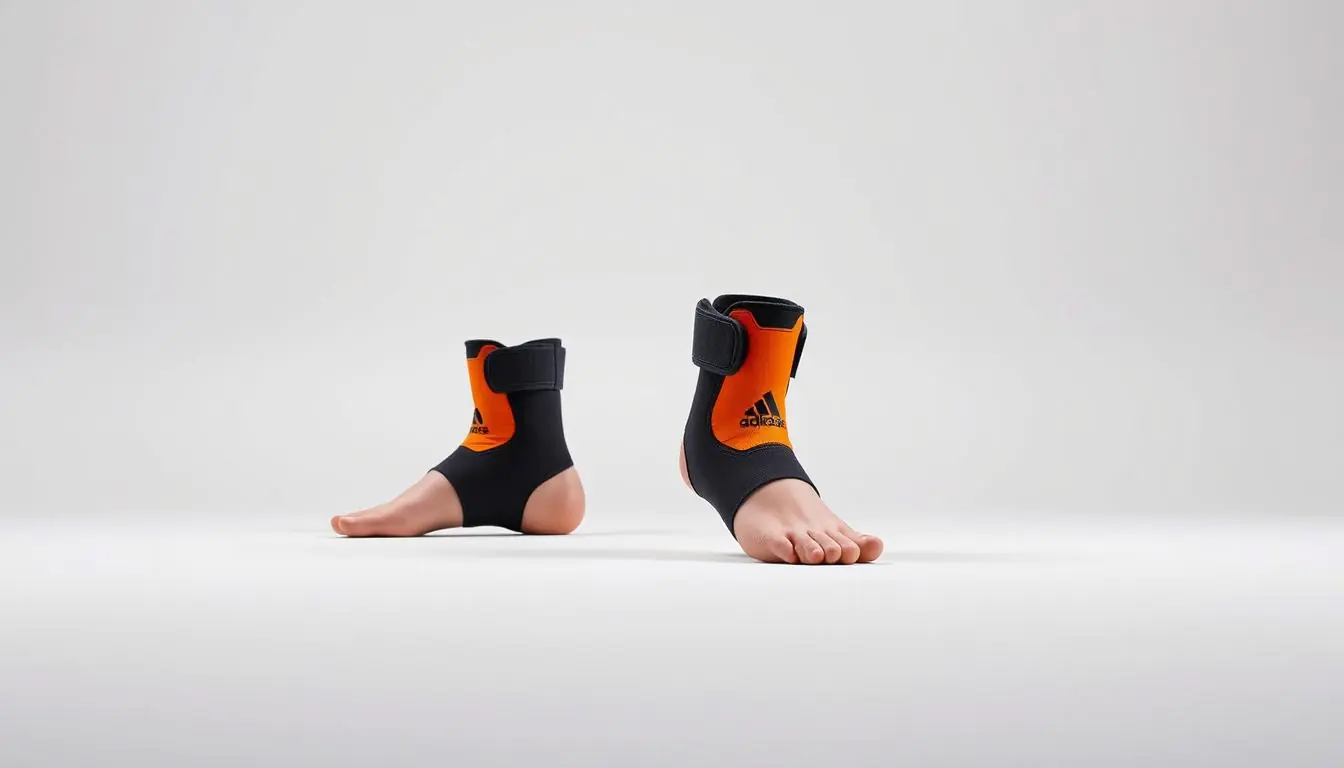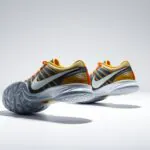As a volleyball player, I’ve felt the shock of an ankle injury. It shows how vital ankle protection is. Every move on the court can be risky. So, finding the right ankle brace is key to protecting your career and love for the game.
Every day, over 25,000 ankle injuries happen in the U.S. Volleyball players are at high risk. Ankle sprains are the most common injury, affecting athletes’ performance and health. I aim to help you find the best ankle protection for safe and confident play.
Choosing the right ankle brace is more than just prevention. It’s about letting athletes perform their best without fear. Whether you play for fun or competitively, knowing about ankle protection can change your game.
Key Takeaways
- Ankle injuries are the most common risk for volleyball players
- Specialized braces can significantly reduce injury risk
- Different support levels suit different injury histories
- Professional-grade braces offer advanced protection technologies
- Proper ankle support enhances athletic performance
Understanding Ankle Injuries in Volleyball
Volleyball is a high-energy sport that puts a lot of stress on players’ ankles. As a volleyball fan, I’ve seen how tough it can be for athletes to deal with ankle injuries. The game’s fast pace and quick movements make it risky for everyone.
Ankle injuries are a big worry in volleyball. Some stats show that ankle sprains make up 44% of all volleyball injuries. This makes them the top injury for players.
Types of Volleyball Ankle Injuries
There are three main types of ankle injuries in volleyball:
- Lateral Ankle Sprains: Happen when the foot rolls inward
- High Ankle Sprains: Less common but can be more serious
- Stress Fractures: Rare but serious injuries
Risk Factors for Volleyball Players
Several things can make volleyball players more likely to get ankle injuries:
- Repetitive jumping
- Quick changes in direction
- How they land
- Having had an injury before
Up to 20% of volleyball players get Functional Ankle Instability (FAI) from all the jumping and landing hard.
Impact on Performance and Career
Ankle injuries can really hurt a player’s game. Moderate to severe ankle sprains can keep a player out for over 10 days. It’s key to prevent ankle sprains to keep playing well.
| Injury Severity | Recovery Time | Performance Impact |
|---|---|---|
| 1st Degree (Mild) | 3-5 Days | Minimal Disruption |
| 2nd Degree (Moderate) | 1-2 Weeks | Significant Disruption |
| 3rd Degree (Severe) | 4-6 Weeks | Major Performance Loss |
Using good prevention methods can help volleyball players stay safe and play their best. This is key for a long, successful career.
Why Volleyball Players Need Specialized Ankle Braces
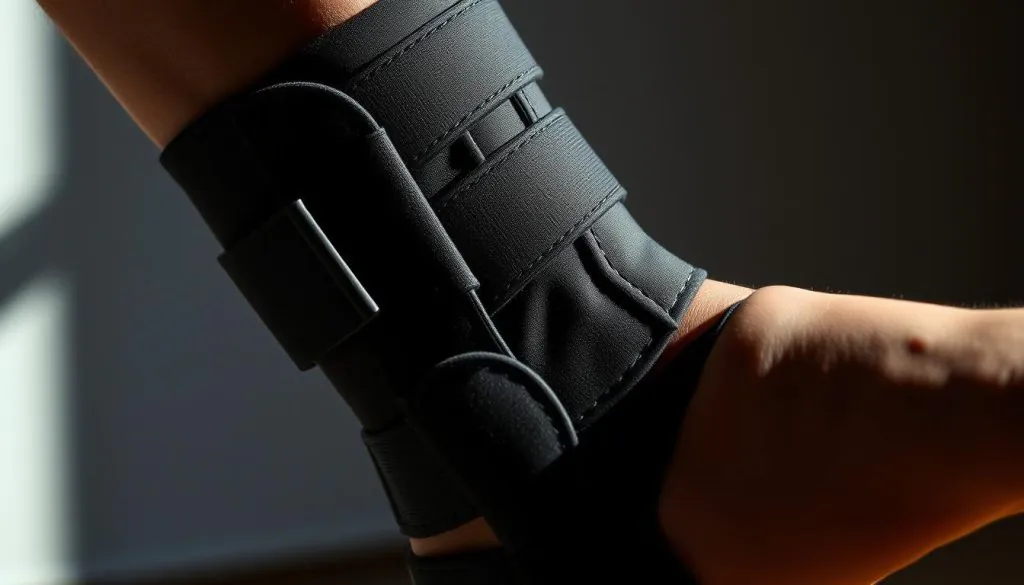
Volleyball is a demanding sport that requires top physical performance. Ankle injuries are a big problem for players. They make up 45.6% of all volleyball injuries. Even worse, 99.3% of these injuries are ankle sprains.
The game’s demands put a lot of stress on players’ ankles. Quick side steps, constant jumping, and landing on others’ feet are common. These actions make ankle protection essential, not just a good idea. Regular strength training can’t always prevent these risks.
- Frequent jumping and landing increase injury risk
- Quick directional changes stress ankle ligaments
- Net play involves complex foot positioning risks
Specialized ankle braces offer targeted protection. They limit harmful rolling motions. This support strengthens ligaments and tendons, reducing strain during games. The benefits of ankle braces go beyond immediate protection. They can also prevent serious injuries that could end a player’s career.
| Injury Type | Percentage | Risk Factor |
|---|---|---|
| Lateral Ankle Sprains | 85% | High |
| High Ankle Sprains | 10% | Medium |
| Fractures | 5% | Low |
For young athletes aiming to play volleyball in high school and college, proper ankle protection is key. A well-designed volleyball-specific ankle brace can make all the difference. It can help ensure a successful, injury-free career.
Top Features to Look for in Volleyball Ankle Braces

Protecting your ankles is key in volleyball. Quick moves and hard landings can cause serious injuries. Knowing what to look for in an ankle brace can greatly improve your game and health.
Volleyball ankle support is more than just protection. The best ankle brace combines important features. It keeps players safe and agile on the court.
Support Level and Mobility Balance
It’s important to find the right balance between support and mobility. Athletes need protection without losing their ability to move freely.
- Recommended support levels vary based on injury history
- Ultra Zoom brace offers moderate support (⚫⚫ rating)
- Ultra 360 Lace-Up provides maximum stability (⚫⚫⚫⚫ rating)
Material Quality and Durability
The right materials make a big difference in ankle brace performance. Using medical-grade compression knits and special fabrics can help volleyball players a lot.
| Material Type | Key Benefits | Best For |
|---|---|---|
| Compression Knit | Reduces inflammation | Players with mild injury risk |
| Mechanical Brace | Enhanced structural support | Athletes with previous injuries |
| Gel-Integrated Braces | Improved circulation | Recovery and pain management |
Comfort and Fit Considerations
An ankle brace should feel like a second skin. Comfort determines consistent use, which is key for preventing injuries. Players should look for braces that are breathable, fit well, and don’t restrict movement.
With ankle forces up to 15 times a player’s body weight during jumps, choosing the right ankle brace is vital. It’s not just about protection; it’s about staying at your best and avoiding injuries that could end your career.
Ultra Zoom: Professional-Grade Protection

I’ve found the best ankle protection for volleyball players. The Ultra Zoom ankle brace is a top choice for keeping athletes safe and performing well.
The Ultra Zoom’s hinged-cuff technology is what sets it apart. It offers great protection against common ankle injuries in volleyball:
- Prevents lateral ankle sprains
- Protects against high-ankle sprains
- Maintains natural movement range
- Restricts excessive ankle turning
The Ultra Zoom ankle brace has a special feature. It molds to your ankle using body heat. This ensures a snug, comfortable fit during games. It’s priced at $31.95, making it a great value for athletes with no or just one ankle injury.
The Ultra Zoom is versatile. It offers protection for hours, not just during games. Athletes like how it prevents injuries without limiting their movement.
It comes in different sizes to fit most players:
- Size S/M: 10.5-14 inch ankle circumference
- Size L/XL: 14-16 inch ankle circumference
It has a one-year warranty and uses Performathane soft shell technology. The Ultra Zoom is the best protection against ankle injuries for volleyball players.
The Science Behind Modern Volleyball Ankle Braces
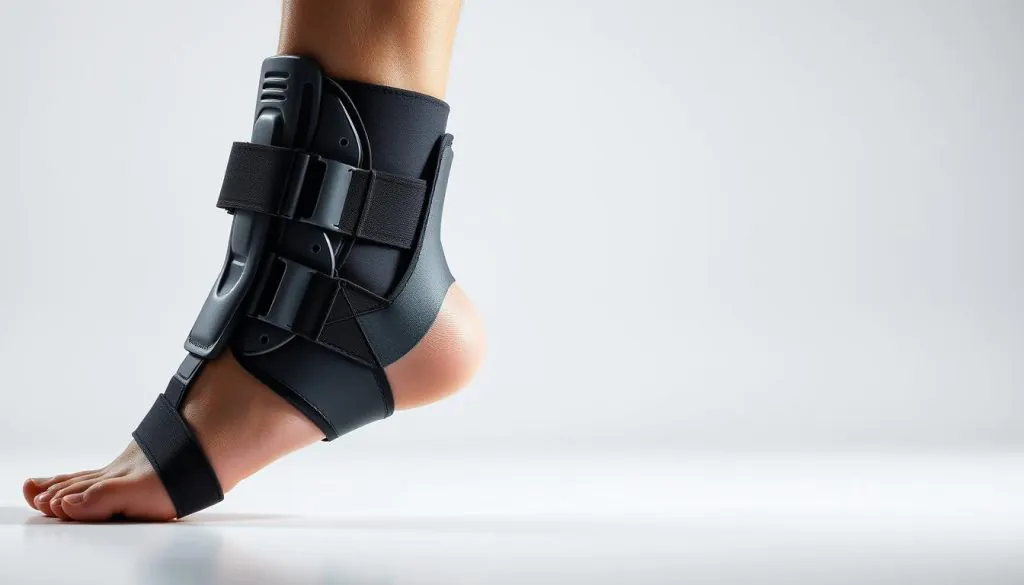
Volleyball players often get ankle injuries. About 85% of these injuries are sprains. New ankle brace technology helps athletes stay safe during games. It uses advanced science to protect the ankle.
New ankle brace designs focus on athlete movement. Engineers study how forces affect the ankle during fast volleyball moves. This leads to better protection systems.
Innovative Technologies in Ankle Protection
Today’s ankle braces have cool features for better safety and performance:
- Hydraulic piston mechanisms that activate three times faster than body movement
- Lightweight materials reducing mobility restrictions
- Advanced compression zones targeting specific ankle stabilization points
Biomechanical Benefits of Advanced Braces
How ankle braces work has changed a lot. Now, they support the ankle without limiting movement. They work with the athlete’s natural movements.
“Our goal is to create protection that feels like a second skin,” says a leading sports biomechanics researcher.
Injury Prevention Mechanisms
Research shows that special ankle braces can lower injury risks. They can cut sprain incidents by up to 50%. This makes them key for volleyball players wanting to stay safe.
| Brace Type | Stability Score | Comfort Rating | Injury Prevention Potentia |
|---|---|---|---|
| Compression Brace | 3.6 | 4.0 | High |
| Lace-up Brace | 4.0 | 3.7 | Medium-High |
| Semi-rigid Brace | 3.1 | 3.1 | Medium |
Understanding the science of ankle protection helps volleyball players choose the right gear. This can prevent injuries.
BetterGuard: Revolutionary Ankle Support System
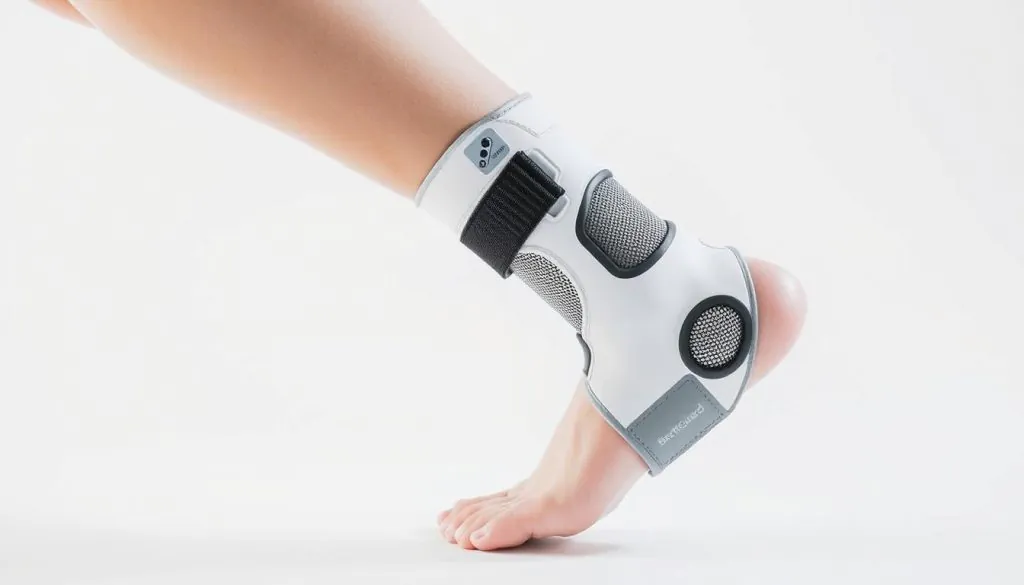
I found a game-changing solution for volleyball athletes looking for top-notch ankle protection. The BetterGuard ankle brace is a new way to protect players on the court. It changes how athletes keep their ankles safe.
The BetterGuard stands out because of its advanced micro-hydraulic piston technology. This tech kicks in fast, like a car’s seatbelt, to protect the ankle. The BG POWER mini-piston helps stabilize the ankle joint up to 4 times faster than our bodies can.
- Developed as part of the NBA Launchpad innovation program
- Recognized with the Sports Technology Award for Injury Prevention
- Prevents excessive inversion and supination movements
The design of the BetterGuard is truly innovative:
| Feature | Specification |
|---|---|
| Material Composition | 62% Polyamide, 38% Elastane |
| Stretch Capability | 4-way stretch fabric |
| Size Options | 5 sizes for right and left foot |
Athletes can now get up to 25% discount on The BetterGuard 1.0. This makes top-notch ankle protection more affordable. Thanks to German engineering and DIN ISO 9001 standards, it offers great support without limiting movement.
The BetterGuard isn’t just an ankle brace – it’s a performance enhancement tool for serious volleyball players.
Comparing Different Types of Volleyball Ankle Braces
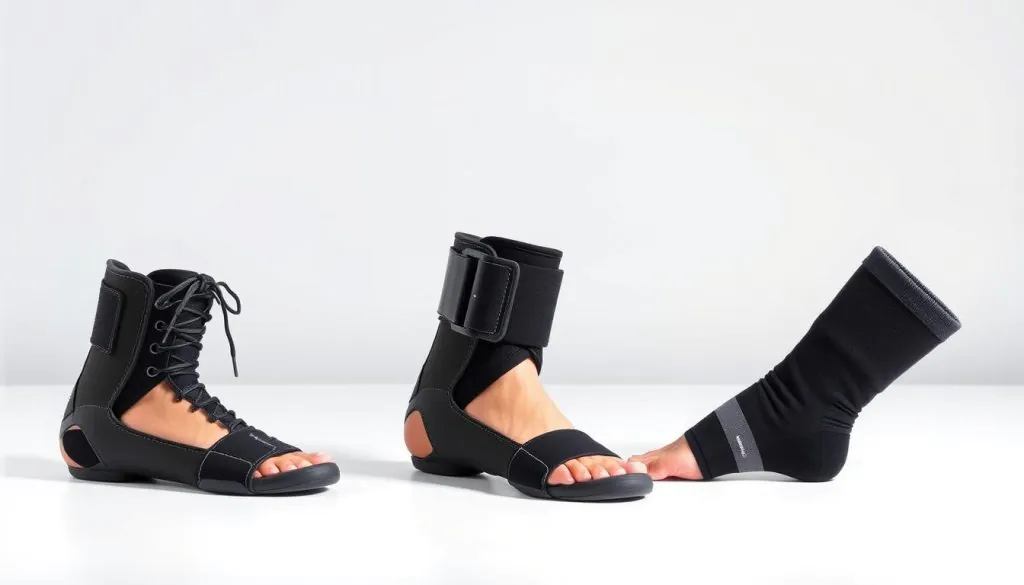
Choosing the right ankle brace is key for volleyball players. It can change the game by protecting and improving performance. Each type of ankle brace has its own benefits, making it important to compare them.
Players will find several ankle brace designs. These designs affect how well they support and feel:
Lace-up vs. Sleeve Designs
Volleyball players face two main choices:
- Lace-up Braces:
- They are the cheapest option
- Offer low to medium support
- Let you adjust how tight they are
- Sleeve Designs:
- They are more comfortable
- Easier to wear
- Keep the ankle snug all the time
Rigid vs. Flexible Support
Support levels differ in various ankle braces:
- Hinged Braces: Medium support
- Rigid Hinged Braces: Maximum support
- Semi-Rigid Designs: Good balance of movement and safety
Price Range Comparisons
Cost is a big factor in choosing ankle braces. Here’s a quick look at prices:
- Ultra Ankle High-5: Under $130 for two
- Active Ankle AS1 Pro: Affordable
- McDavid Ankle Brace: Well-reviewed
- SNEINO Ankle Brace: A budget option
The best ankle brace depends on your needs, position, and past injuries. Front row players need stiffer support. Back row players might want more flexibility.
Proper Fitting and Wearing Guidelines
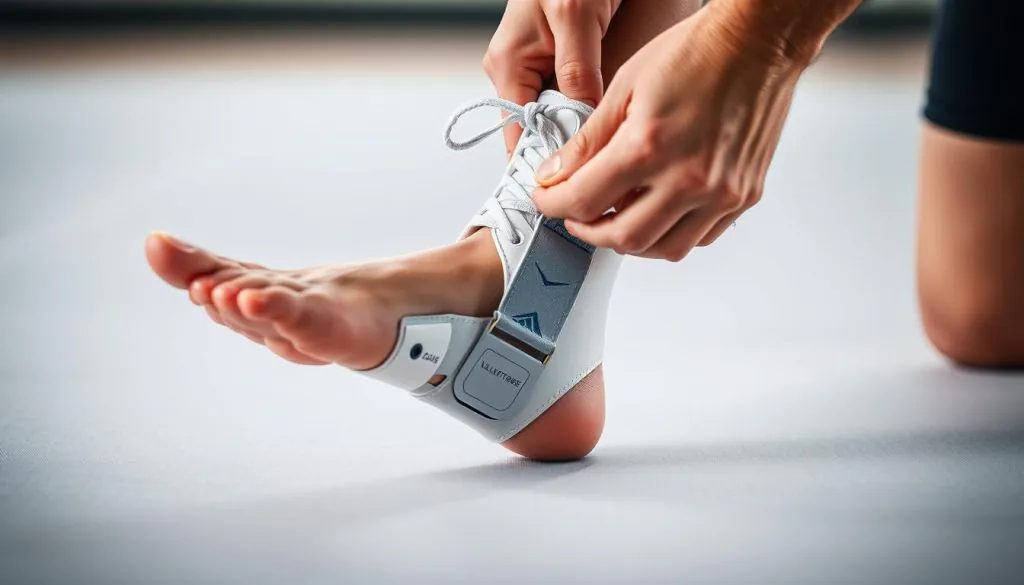
Choosing the right ankle brace for volleyball is key for top performance and avoiding injuries. First, learn how to fit ankle braces properly for the best support and comfort.
Here are some important guidelines to follow:
- Measure your ankle circumference accurately before buying
- Check the brace’s sizing chart carefully
- Make sure the brace fits snugly but doesn’t cut off blood flow
- Try on the brace with the shoes you’ll wear during volleyball
When fitting an ankle brace, focus on these key points:
- Compression Level: It should support firmly but not too tightly
- Material Flexibility: Pick breathable materials that let your ankle move naturally
- Stability Points: Make sure the brace supports your ankle’s ligaments well
Different ankle brace designs need different wearing methods. For lace-up braces, start by loosening all laces. Then, place the brace in the middle of your ankle. Tighten the laces slowly to spread the pressure evenly.
| Brace Type | Best For | Fitting Recommendation |
|---|---|---|
| Sleeve Design | Light Support | Slide on smoothly, minimal adjustment needed |
| Lace-up Brace | Maximum Stability | Carefully lace for personalized compression |
| Rigid Brace | Severe Injury Prevention | Ensure precise alignment with ankle bones |
Remember, fitting an ankle brace is not one-size-fits-all. Your foot shape and how you play volleyball will help pick the best brace for you.
Maintenance and Care Tips for Ankle Braces
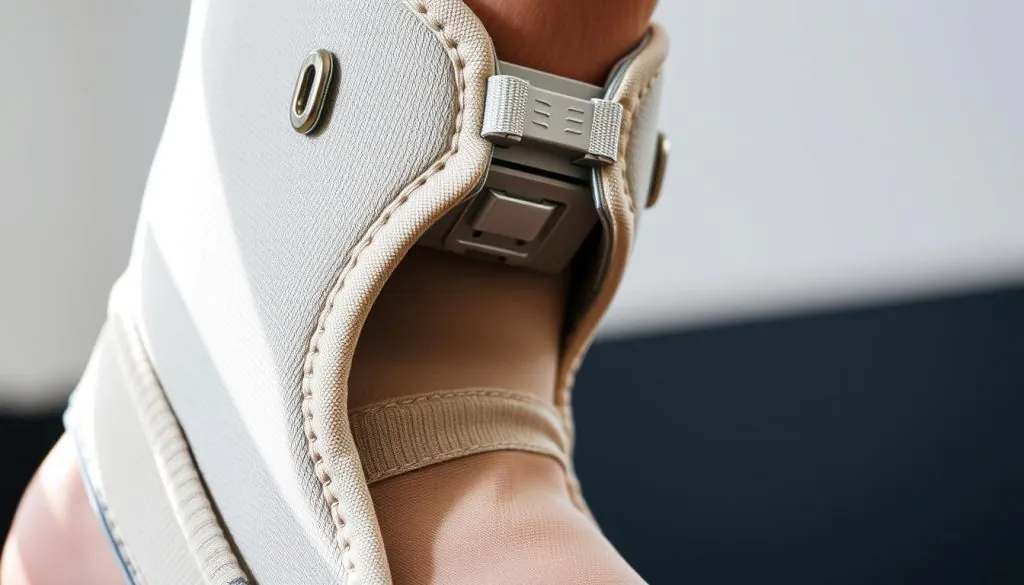
Keeping your ankle brace clean is key to protecting your ankles during volleyball. It also helps your gear last longer. Regular care keeps your brace clean, working well, and ready for action.
Here’s how to clean your ankle brace:
- Clean it every few days with mild soap and cold water
- Let it air dry before wearing it again
- Don’t use harsh chemicals that could harm the material
- Check straps and seams for wear
Managing moisture is important for ankle brace care. Keeping bacteria and odors away needs careful cleaning and drying. Try a mix of baking soda and vinegar for a natural way to control smells. This method kills bacteria without harming the brace.
Where you store your ankle brace matters too. Keep it in a place with good air flow, away from sunlight. This helps prevent damage and keeps the brace supportive.
Here are more tips for care:
- Switch between different braces to avoid overuse
- Get new braces if the old ones are damaged
- Make sure the brace fits right
- Oil moving parts if needed
Following these care tips will make your ankle braces last longer. They’ll keep protecting your ankles in every volleyball game.
Professional Athletes’ Recommendations
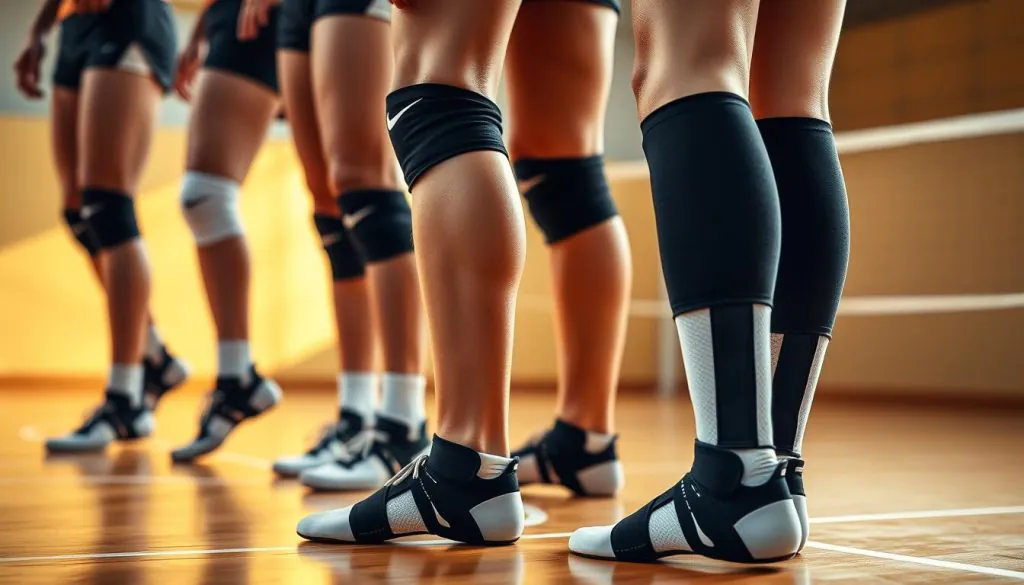
Professional volleyball players know how important ankle braces are. They protect their performance. Athletes share how the right brace can change their game and prevent injuries.
Success Stories That Inspire
“I love Ultra Zoom because it gives me the confidence to make ‘crazy’ blocking moves on the court with the reassurance that one misplaced step won’t result in a week off my feet.” – Jenna Rosenthal, Professional Volleyball Player
Many athletes say ankle braces have changed their careers. They talk about three main benefits:
- Increased confidence during aggressive plays
- Reduced recovery time from minor injuries
- Enhanced performance consistency
Performance Impact Insights
Volleyball is all about quick moves and complex skills. Ankle braces help players go further without risking injury.
| Ankle Brace Model | Support Level | Performance Benefit |
|---|---|---|
| Ultra Zoom | 2/4 (Prevention) | Moderate Mobility Preservation |
| Hinged-Cuff Brace | 4/4 (Recovery/Prevention) | Maximum Mobility Maintenance |
| BetterGuard 2.0 | 5/5 (Fit & Comfort) | Advanced Injury Risk Reduction |
Long-Term Career Benefits
Using top-notch ankle braces helps athletes play longer. Proactive joint protection turns big injuries into small ones.
The best volleyball players see ankle support as key to lasting success. It’s not just about safety; it’s about being great for years.
Common Myths About Ankle Braces
Volleyball players often face many ankle brace misconceptions. These can stop them from choosing the right protection. Let’s look at the most common myths and find out what’s true.
One big myth is that ankle braces weaken muscles. Research shows this is not true. Studies say that not using your muscles is what leads to weakness, not the brace itself.
- Myth: Ankle braces reduce athletic performance
- Reality: Modern braces are designed to enhance mobility
- Myth: Braces are only necessary after an injury
- Reality: Prevention is key in volleyball protection
Another myth is about knee injuries and ankle braces. Experts have looked into this and found no proof. Dr. Phil Page, a sports medicine expert, says there’s no study that shows braces weaken muscles.
A trade-off of 1/100th of a second in performance for injury prevention is considered worthwhile in team sports like volleyball.
Choosing the right ankle brace is important. There are different types, from hinged braces that let you move naturally to more restrictive ones for chronic instability. Volleyball players should pick braces that support without limiting their play.
Knowing the truth about ankle brace myths helps players make better choices. This protects their performance and keeps their joints healthy for the long term.
Conclusion
Exploring volleyball ankle protection, I found that the right ankle brace is key for both safety and performance. Ankle sprains are common in indoor volleyball, making support essential for all players.
Players with fewer than four sprains can benefit from specialized braces to lower injury risks. Elite athletes prove that combining technical training with good ankle support is effective against injuries.
It’s important to note that not all ankle braces are the same. When picking a brace, think about support level, material, and your injury history. Hard-shell braces have shown to reduce injuries without affecting performance.
Investing in the right ankle protection is a smart move for your volleyball career. Whether you play in college or just for fun, the right brace keeps you confident and strong. Protect your ankles and improve your game.
FAQ
Why do volleyball players need specialized ankle braces?
Volleyball players need ankle braces because of the sport’s demands. They jump a lot, move quickly, and sometimes land on other players. These braces protect against injuries from volleyball’s intense play.
How do ankle braces help prevent volleyball injuries?
Ankle braces support your ankle by limiting too much movement but letting it move naturally. They use special technologies to protect only when needed, like a car’s seatbelt.
Can ankle braces actually improve my volleyball performance?
Yes, modern ankle braces can help you play better. They give you confidence to make bold moves, lower injury risk, and support your ankle without limiting your movement. Many pros wear them to stay safe and play consistently.
How do I choose the right size ankle brace?
To find the right size, measure your ankle and check the manufacturer’s chart. Make sure it fits snugly but doesn’t cut off circulation or limit movement.
How often should I replace my volleyball ankle brace?
How long an ankle brace lasts depends on how often you use it and how hard you play. Check it often for wear and replace it every 6-12 months, or sooner if it’s not supporting your ankle as well.
Are ankle braces only for players with previous injuries?
No, ankle braces are important for all players to prevent injuries. They protect against sprains and other ankle injuries, which are common in volleyball.
Do ankle braces weaken my ankle muscles over time?
This is a myth. Ankle braces actually help your ankle muscles when used right. They support your ankle during intense play, letting your muscles move and grow naturally.
Can I use the same ankle brace for practice and game play?
While many ankle braces are versatile, it’s best to have different ones for practice and games. Some players switch between braces to keep them in good condition for both activities.
How do I clean and maintain my volleyball ankle brace?
Wash your ankle brace with mild soap and cool water after each use. Let it dry away from heat or sunlight. Don’t use harsh chemicals or machine wash, as they can harm the materials.
Are volleyball ankle braces comfortable to wear?
Yes, modern ankle braces are made to be comfortable. They use materials that fit your body, keep you dry, and breathe well. Many have technologies that adjust to your body heat for a snug fit during long games.
